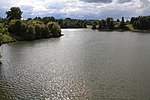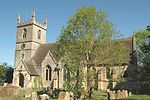Oxford Bus Museum
1967 establishments in EnglandAutomobile museums in EnglandBus museums in EnglandMuseums established in 1967Museums in Oxfordshire ... and 3 more
Transport in OxfordshireUse British English from December 2016West Oxfordshire District

The Oxford Bus Museum is a transport museum at Long Hanborough, West Oxfordshire, England, about 4 miles (6.4 km) northeast of Witney and 7 miles (11 km) northwest of the city of Oxford. The museum houses a collection of 40 historic buses and coaches, the remains of four horse trams and a replica City of Oxford Tramways Company tram. The site includes the Morris Motors Museum, which has a collection of 12 Morris Motors cars and vans. The two museums' collections also include many smaller historical artifacts. The museum is owned and operated by the Oxford Bus Museum Trust, a registered charity.
Excerpt from the Wikipedia article Oxford Bus Museum (License: CC BY-SA 3.0, Authors, Images).Oxford Bus Museum
Main Road, West Oxfordshire Hanborough
Geographical coordinates (GPS) Address Nearby Places Show on map
Geographical coordinates (GPS)
| Latitude | Longitude |
|---|---|
| N 51.825417 ° | E -1.372171 ° |
Address
Mini
Main Road
OX29 8GJ West Oxfordshire, Hanborough
England, United Kingdom
Open on Google Maps








